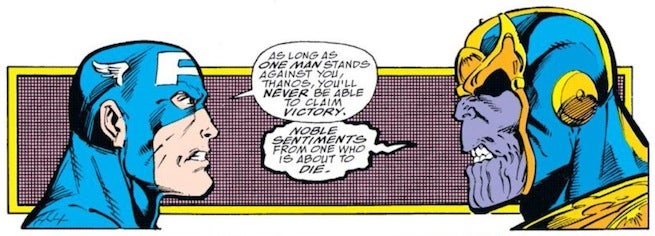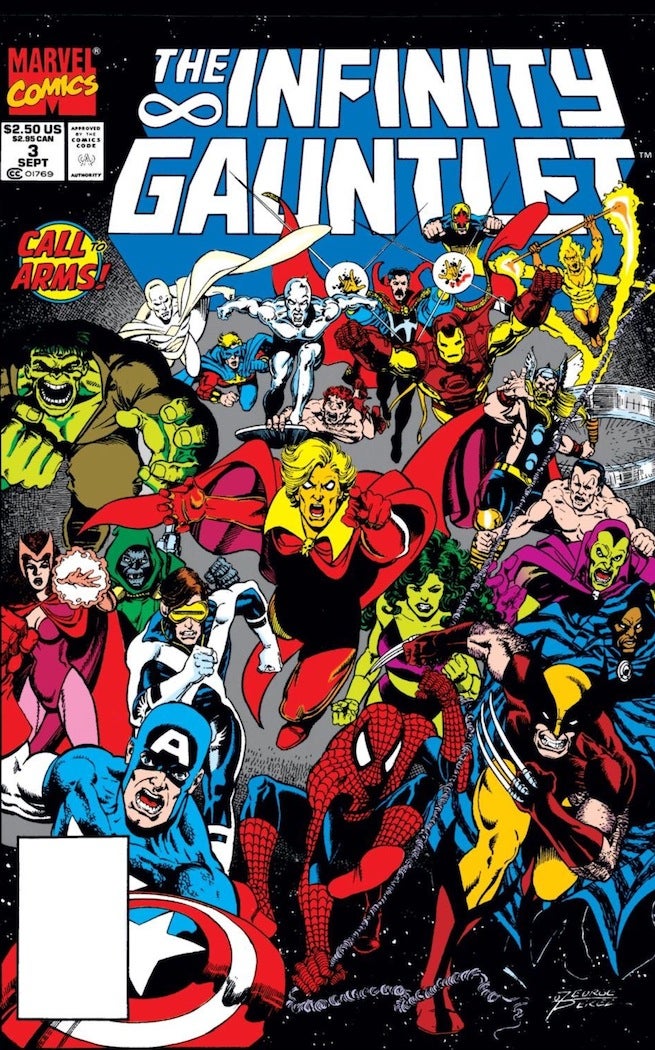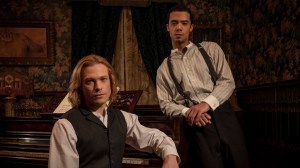We here at ComicBook.com are unquestioned fans of the mercurial decade of comics known as the 90s. This was of course the era that gave birth to cover gimmicks, polybags and dramatic character redesigns, while also making a habit of pushing stories that reshaped status quos (deaths, brainwashing and clones). In other words, the 90s were very similar to what we’re currently experiencing in the comic book marketplace, just with a little more foil and glow-in-the-dark ink (but today we do get a month full of lenticular covers).
Videos by ComicBook.com
“90s Nirvana” will be a regular list feature that discusses the key storylines and some of the more famous/popular individual issues of the decade. Along the way, we hope this feature will help you determine if the featured comic(s) are worth revisiting or whether or not they should stay tucked away in a quarter box at a local comic book shop.
But enough chitchat. Let’s talk 1991’s The Infinity Gauntlet.
The six-part Infinity Gauntlet miniseries, which was written by Marvel Cosmic-verse godfather Jim Starlin, with pencils from George Perez and Ron Lim, is considered one of the most famous event comics in Marvel history. The storyline stars the “Mad Titan” (and Starlin creation) Thanos, and describes what happens after he comes into possession of an omnipotent macguffin, aptly dubbed, the Infinity Gauntlet. As you might imagine, Thanos wreaks a fair bit of carnage on the Marvel Universe with the gauntlet, at one point even snapping half of the world out of existence. So it’s all up to the remaining heroes to stop him.
Today, the Infinity Gauntlet is getting an increasing amount of exposure across all media, especially after Thanos’s appearance in the mid-credits teaser of 2012’s The Avengers film. Marvel Studios has essentially confirmed that its building its current cinematic universe to culminate in an Infinity Gauntlet adaptation (entitled The Infinity War), while in the comics, Thanos can be found all over the place, in some instances with Starlin back at the helm.
But does The Infinity Gauntlet justify the iconic status it has seemingly achieved, or are people misremembering/forgetting some of the mini’s pronounced flaws? Let’s talk a look:
The Good
1. Thanos is Wonderfully Evil
That might sound a bit calloused, but the selling point of The Infinity Gauntlet will forever be Thanos. It’s the definitive Thanos story and also a power fantasy on steroids for anybody who likes to read a comic where the bad guy seemingly wins. Starlin does an amazing job establishing Thanos’s uncompromising evil – the fact that he just snaps a few billion people out of existence as if it was nothing (because, for him, it was) is one of the most famous scenes in Marvel Comics history. To top it off, Thanos’s battle with the surviving heroes, where he calmly destroys them, one-by-one, until only Captain America remains, is the stuff of legends. Thanos rose to stardom during the 1970s under Starlin’s pen, but the writer here elevates him to icon status. Thanos’s characterization in Infinity Gauntlet is the only reason moviegoers were so ecstatic when the Mad Titan popped up at the end of The Avengers.
2. Captain America’s Stand
In one of the mini’s most stirring moments, Captain America is the last hero standing after Thanos systematically dispatches of all of his teammates – many in absolutely terrifying fashion. But Cap is undeterred by Thanos and his power. For a hero who is well known for his speeches, his final words to Thanos might be his most dramatic, letting the villain know that as long as one of the heroes continues to stand, they will challenge him until the bitter end. Of course Thanos swats Cap away like a fly, but that scene is just the best.
3. Its Scope
The Infinity Gauntlet is a big event for people who love big events. Even after half the Marvel Universe is wiped out in the first issue of the series (including such luminaries as the Fantastic Four and Daredevil), Starlin, Perez and Lim still manage to cram a lot of characters into this story in a way that doesn’t feel overly bloated or weighed down. The superhero resistance, interestingly enough, is led by Adam Warlock, an old 70s cosmic hero who wasn’t created by Starlin, but might as well have been considering all of the famous stories Starlin wrote using the golden-hued dynamo. While other deeper cut characters like Marvel’s Celestials join the fight against Thanos. Meanwhile, the art, especially the Perez portions, rises to the story’s grandeur, producing some dramatic cosmic landscapes, including Thanos’s super cool floating fortress.
The Bad
1. A Lack of Consequences
Even before it became commonplace to kill off a character just for them to be resurrected again months later, it was a bit unbelievable – as in, totally unable to be believed – that Marvel would really kill off half of its cast of heroes with a snap of Thanos’s fingers. And when Thanos goes on to kill off the remaining heroes in Infinity Gauntlet #4, it was fairly obvious that it was a question of *when* these characters would return, rather than *if.* As such, the predictability and lack of consequences from Thanos’s extreme acts of evil take a little bit of the fun out of the story. Perhaps if only one or two major characters were killed off, it would have been far more believable that they would remain dead – thereby adding more drama and tension to Thanos’s actions.
2. The George Perez/Ron Lim Artist Changeover
George Perez is unquestionably a comic book industry icon in terms of illustrators, while Ron Lim was one of the best artists to rise to fame in the 90s, but the overall aesthetic of The Infinity Gauntlet is hurt by how the book abruptly switches from Perez to Lim about halfway through the series. Perez’s style is far more traditional and classic, while Lim definitely had a 90s edge to him in terms of exaggerated anatomy. If one or the other stayed on the book for its duration, there wouldn’t be any strikes against The Infinity Gauntlet’s artwork, but mixed together, the tonal clashes of Perez/Lim is too noticeable.
3. A Disappointing Ending
Starlin writes himself into a bit of a corner once Thanos dominates the heroes in Infinity Gauntlet #4, which leads to an unfortunately clunky ending to an otherwise epic miniseries. Because there’s no logical or reasonable way for anyone to overpower Thanos when he’s wearing the gauntlet, his ultimate downfall comes in the moments after the Mad Titan defeats the Celestial Eternity. He leaves his physical body and becomes what is described as the “living embodiment of the universe.” In that moment, his granddaughter, Nebula, swipes the gauntlet from him and reverses all the damage that was done. And just like that, the heroes are revived and order is restored. Thanos doesn’t win, but he never technically loses either. And more importantly, he never gets his comeuppance. It’s extraordinarily unsatisfying and something Marvel Studios has to address when they develop an ending to the two Infinity Wars films.
Things That Make You Go Hmm…
1. The Wolverine/Hulk Bromance
There’s a quick scene in the lead-up to the heroes vs. Thanos showdown where Hulk and Wolverine are sitting next to each other talking about how they’re two peas in a pod because they’re just a bunch of monsters unlike everyone else. I guess they decided in that moment to forgive each other for all the times they tried to kill each other. Either way, it’s a weirdly forced moment that might strike the fancy of Wolvie and Hulk fans, but adds nothing to the overall narrative.
2. Silver Surfer and Warlock’s Plan
For reasons that aren’t entirely clear beyond the fact that Starlin was famous for writing the character, Warlock becomes the de facto leader of the heroes in their fight against Thanos. And while Thanos is decimating everyone with the gauntlet, Warlock stands off on the sidelines with Silver Surfer, preaching patience since he has a master plan that will defeat the villain. His plan? It’s basically to wait until everyone else is dead and to then have Surfer glide by on his board and snatch the gauntlet. Naturally, such a complex, well-thought out plan has to work right? Well, no, Surfer totally misses his mark and the game with Thanos continues.
Final Verdict: B-
The Infinity Gauntlet is a tremendous amount of fun and in terms of miniseries/events is a true highlight for Marvel. However, for a story that is lionized by its fan base, there are far too many flaws to overlook, including a very unsatisfying ending, inconsistent art, and some wacky character moments that feel out of place. It’s easy to see why Marvel wants to adapt elements of this story for the big screen, but fans expecting a panel by panel translation should temper expectations since Marvel will have to change a fair bit from the comics in order to produce a more coherent movie.


















